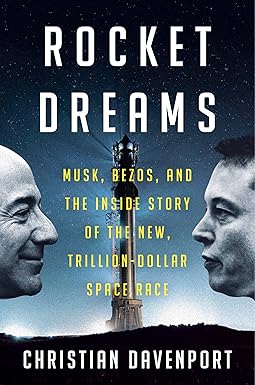Centauri Dreams
Imagining and Planning Interstellar Exploration
New Horizons: Hubble Hunts KBOs
My guess is that the public thinks of the Hubble Space Telescope largely in relation to deep space objects. The Hubble Ultra Deep Field is a case in point, a region of the sky in the constellation Fornax that is no more than a tenth of the width of a full moon, but one that contains 10,000 galaxies. An image of the HUDF augmented by near-ultraviolet data has had considerable play in the media, showing star birth in galaxies five to ten billion years ago. It’s too lovely not to show here.
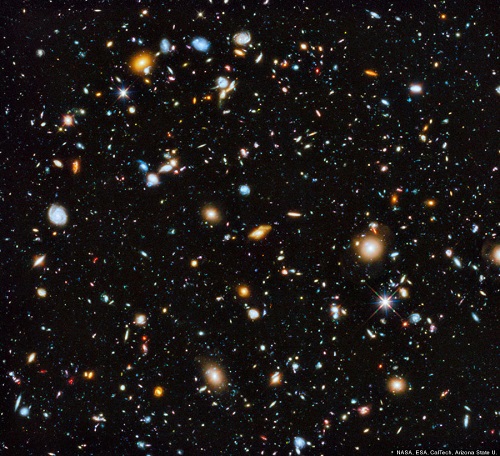
Image: The Hubble Ultra Deep Field with near-ultraviolet data, a false-color image that is the result of data acquisition from 841 orbits between 2003 and 2012. Credit: NASA/ESA/Caltech/Arizona State.
The HUDF attests to Hubble’s range, but we also know from Hubble’s studies of objects in our own Solar System that it can support ongoing planetary missions. Astronomers will now use the space observatory to help find tiny objects against the background of an immense starfield in Sagittarius. After consideration of the mission and the value of the data it will return, the Hubble Space Telescope Time Allocation Committee has recommended that the instrument be used to search for a Kuiper Belt Object that New Horizons can visit after its flyby of Pluto/Charon in 2015, a search contingent upon results of a pilot observation program using Hubble data.
We have two Voyagers still sending data as they push into interstellar space, but only New Horizons has a fully functioning set of instruments and the capability of making the necessary course alterations to perform a KBO flyby. The problem has been to identify the target, a hunt that could begin no earlier than 2011 because KBO candidates needed to be converging on the region of space that New Horizons can reach after the Pluto/Charon encounter. The 8.2-meter Subaru Telescope in Hawaii and the 6.5-meter Magellan Telescopes in Chile have so far been deployed on the task but it looks like it will take Hubble to make the call.
For of the roughly fifty new KBOs that the Subaru and Magellan instruments have thus far identified, none is within range of the spacecraft’s ability to maneuver. This is an extremely difficult search field, one that looks into the plane of the galaxy toward Sagittarius, and astronomers are searching for something that is both small and likely to be as dark as charcoal. But finding a target is important — the Kuiper Belt consists of debris from the Solar System’s formation, and we’ve never had the opportunity to get a close-up look at one of these objects.
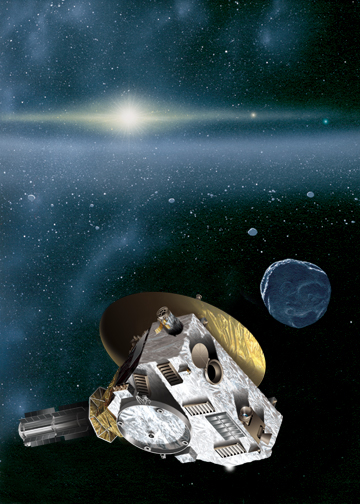
If Subaru and Magellan haven’t been able to find the right KBO, Hubble will try something different, turning at the rate that KBOs are predicted to move against the background stars. As this Space Telescope Science Institute news release explains, the result will be that KBOs will show up as pinpoint objects amidst a swarm of streaky background stars. Assuming the initial test observations — 40 orbits of Hubble observing time — show that the telescope can find at least two KBOs of the specified brightness, additional observing time covering a period of 156 orbits will be allotted to search a field of view the angular size of the full Moon.
Let’s wish Hubble success because New Horizons is the successor to the Voyagers, like them involved in a journey that should captivate and inspire our culture. The more science we can get out of it, the better, even though putting a payload past Pluto/Charon is itself a grand accomplishment. As for Hubble, its efforts on behalf of New Horizons point to its previous discovery of four small moons in the Pluto/Charon system as well as its search for dust rings that might have compromised the mission. Just as Hubble has proven its worth again and again in terms of planetary science (and don’t forget its contributions to the Dawn mission), we can hope for equally impressive accomplishments from the coming James Webb Space Telescope.

What to Look for at Charon
Let me suggest that you mark August 25th on your calendar. It’s the day we celebrate the 25th anniversary of Voyager 2’s closest approach to Neptune in 1989. That would be reason enough to look back and remember — marveling all the while at the Voyagers’ continuing mission — but it’s also the day when New Horizons will cross the orbit of Neptune. At work, as principal investigator Alan Stern points out in his latest PI’s Perspective, is ‘cosmic coincidence not design,’ but what a moment it will be as New Horizons moves at last into ‘Pluto space.’
90 percent of the long journey is over, with a bit more than 300 million miles to go before the encounter with Pluto/Charon next summer. Newly awakened from hibernation, the spacecraft will be put through a complete checkout of its onboard systems and scientific instruments, as well as conducting its first optical navigation campaign to study the approach into Pluto. Stern also reports that the upcoming cruise science will include imaging Pluto and its moons to study their light curves, seen by the spacecraft at a different angle than can be observed from Earth.
One more period of hibernation will occur before New Horizons is awakened in December, at which point the beginning of the encounter phase will be closing in. Recent work out of NASA GSFC, and an accompanying paper in Icarus, thus comes against the backdrop of a mission that will soon be answering many of our questions about this distant system. Alyssa Rhoden and team have developed a model that points to how we can study the possibility that Charon once had an underground ocean. Says Rhoden:
“Our model predicts different fracture patterns on the surface of Charon depending on the thickness of its surface ice, the structure of the moon’s interior and how easily it deforms, and how its orbit evolved. By comparing the actual New Horizons observations of Charon to the various predictions, we can see what fits best and discover if Charon could have had a subsurface ocean in its past, driven by high eccentricity.”
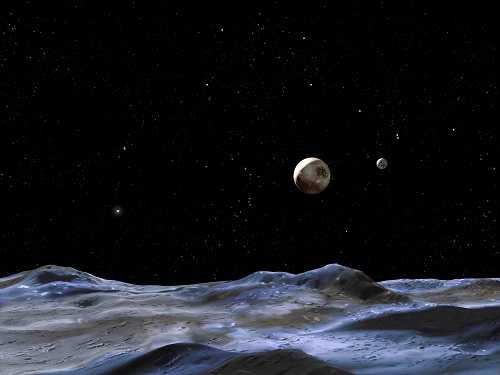
Image: This artist concept shows Pluto and some of its moons, as viewed from the surface of one of the moons. Pluto is the large disk at center. Charon is the smaller disk to the right. Credit: NASA, ESA and G. Bacon (STScI).
Both Europa and Enceladus show evidence for interior oceans, each experiencing tides that cause the interior to flex and heat enough to keep water under the ice in liquid form. What happened in the Pluto/Charon system depends upon its history. Charon could have had a highly eccentric orbit in the past that generated large enough tides to produce surface fractures. As tidally induced friction occurred in the interior of both Pluto and Charon, Pluto’s rotation would have slowed while Charon’s speeded up as the moon moved further away. Rhoden continues:
“Depending on exactly how Charon’s orbit evolved, particularly if it went through a high-eccentricity phase, there may have been enough heat from tidal deformation to maintain liquid water beneath the surface of Charon for some time. Using plausible interior structure models that include an ocean, we found it wouldn’t have taken much eccentricity (less than 0.01) to generate surface fractures like we are seeing on Europa. Since it’s so easy to get fractures, if we get to Charon and there are none, it puts a very strong constraint on how high the eccentricity could have been and how warm the interior ever could have been.”
So we have one more thing to look for as we approach Pluto/Charon next year. Bear in mind that Charon is unusually massive when compared to the body it orbits, about one-eighth of Pluto’s mass. Scientists believe the moon formed much closer to Pluto as the result of an impact that ejected material from Pluto to form the system of moons. Charon’s orbit is now circular, with a rotation rate that keeps Pluto and Charon showing the same side to each other at all times. Without significant tides in its present orbit, the odds are that any underground ocean inside Charon is long frozen.
The paper is Rhoden et al., “The interior and orbital evolution of Charon as preserved in its geologic record,” Icarus, published online 30 April 2014 (abstract). This NASA news release has more.

Transcendence Going Interstellar: How the Singularity Might Revolutionize Interstellar Travel
Andreas Hein, who has appeared in these pages before on the subject of worldships, here speculates about a much different kind of traveling: The uploading of consciousness. Andreas is Deputy Director of the Initiative for Interstellar Studies (I4IS), as well as Director of its Technical Research Committee. He founded and leads Icarus Interstellar’s Project Hyperion: A design study on manned interstellar flight. Andreas received his master’s degree in aerospace engineering from the Technical University of Munich and is now working on a PhD there in the area of space systems engineering, having conducted part of his research at MIT. He spent a semester abroad at the Institut Superieur de l’Aeronautique et de l’Espace in Toulouse, working on the numerical simulation of the hypervelocity impact of space dust on spacecraft antennas, and also worked at the European Space Agency Strategy and Architecture Office on stakeholder analysis for future manned space exploration. Today’s essay is drawn from his chapter in the upcoming book Beyond the Boundary, to be published by the Initiative for Interstellar Studies.
by Andreas Hein

In the movie “Transcendence”, Dr. Will Caster’s consciousness, played by Johnny Depp, is “uploaded” into a quantum computer. This feat unleashes a cascade of rapidly accelerating technological changes, culminating into a “technological singularity”. It is probably the first time that the technological singularity plays a central role in a Hollywood blockbuster. However, the hypothetical concept of uploading one’s consciousness into a computer, also called “mind uploading” or “whole brain emulation”, has been a topic in science fiction for decades. Seemingly far-fetched, mind uploading might be actually not very far from reality. Recently, the European Union’s Human Brain Project has formulated its objective to simulate the human brain. With an anticipated budget of over one billion Euros, it is the largest project of this kind ever conducted. Although the Human Brain Project’s objective is to simulate the human brain, it has spurred discussions about the prospects of mind uploading. Mind uploading might have truly transformative consequences for our civilization. Among them are the potential for digital immortality and the creation of emulated minds which might transform knowledge work, as they can be copied and used on-demand for intellectually demanding tasks (Hanson, 2008a & 2008b).
Mind uploading also opens up exciting opportunities for interstellar flight.

Image: Part of a poster for the movie “Transcendence.” Credit: Alcon Entertainment / DMG Entertainment / Straight Up Films.
In this article, I will try to give a brief overview of existing concepts for using mind uploading for interstellar travel, as well as proposing novel concepts, which might radically change the way humans would travel to the stars. Furthermore, potential mission architectures are presented, having profound consequences on the way such a mission accomplishes its objectives.
First of all, I clarify what is meant by “mind uploading” in this article. “Mind uploading” is understood here as the transfer of mental content, for example long term memory, or consciousness, from the brain substrate into an artificial device, a digital, analog, or quantum artificial neural network (Sandberg & Bostrom, 2008). Once uploaded, the mental content can be “run” on the device as a simulation or simply stored. Analogously, “mind downloading” is defined as the transfer of mental content from an artificial device to brain substrate. Mind downloading goes hand in hand with the recreation of the human body in its entirety. Otherwise, mind downloading would not make a lot of sense for interstellar travel. If the whole body is up- and downloaded, this can be termed “human uploading” or “whole body emulation”. In this article, the boundaries between “mind uploading” and “human uploading” are often blurred. They are therefore considered to be exchangeable.
The main objective of manned interstellar travel is transporting humans to another star system and starting a new civilization there. The basic idea of using mind uploading for interstellar travel is to upload the human mind and/or body and to recreate it at the target destination. To jump-start a new, thriving civilization at the target destination requires the transfer of knowledge for performing all necessary activities. Transporting humans in digital form has huge benefits for interstellar travel: Firstly, it leads to extreme mass savings. No longer are large habitats and complex life-supporting systems needed. At the same time it offers the capability to “resurrect” living humans at the target destination, including their knowledge and thus culture, thus greatly facilitating the start of a new civilization. Knowledge and technology is transferred from the emulated brains at the target destination, either by education or “hard-wiring” emulations into biological brains.
Of course, one could speculate about the radical possibility of the complete replacement of biological life by artificial life. In this scenario, the spacecraft would be rather the “seed” for a non-biological civilization (Kurzweil, 2005).
Interstellar colonization concepts based on mind uploading can be categorized as shown in Table 1.
Table 1: Colonization tasks mapped to interstellar colonization concepts based on mind uploading
| Function | Concept 1 | Concept 2 | Concept 3 | Concept 4 | Concept 5 |
|---|---|---|---|---|---|
| Transport Humans | Hardware static storage | Brain emulations | Hybrid: genetic material + emulations | Electromagnetic waves | Transmit electromagnetic waves / nano spacecraft via wormholes |
| Construct colony | Macroscopic replicators | Micro / nano replicators | |||
| Establish civilization | Emulations + biological humans | Cyborgs | Emulations + biological humans | Emulation cities (Hanson, 2008a, 2008b) | Matrioshka brain (Bradbury, 2001) |
In order to transport humans as emulations, they need to be uploaded. Uploading might be accomplished by some advanced form of scanning. Hans Moravec was one of the first to envision a form of brain scanning, by which the human brain would be incrementally uploaded in a destructive way (Moravec, 1988). Kurzweil and others envisioned non-destructive ways of uploading, for example by using nano-scale robots that scan the brain from within (Kurzweil, 2005, p.145).
Creating a copy of the brain is a daunting task. It is far more than copying just the structure of the brain, but also the structure of individual neurons and their linkages to other neurons. What is further needed is to copy the behavior of individual neurons and larger structures in the brain. This is similar to a technical system. The understanding of how the parts of a car are related to each other does not prescribe how they work together to perform the desired function of transporting passengers. It can only be inferred by painstakingly assessing how individual components and larger groups of components perform subfunctions. These subfunctions together perform the top-level function. This reverse engineering method is called a bottom-up approach. As an alternative, one can analyze functions top-down, by first decomposing the top-level functions into subfunctions. Similar reverse engineering approaches were proposed for creating brain emulations (Sandberg & Bostrom, 2008).
After an emulation has been created, it could be switched, copied, run, and also switched off as desired (Hanson, 2008a & 2008b). For an interstellar mission, emulations could be stored and first activated at the target destination. This would save energy for running emulations during flight. Having arrived at the target destination, one can imagine how activated emulations first assess the environment within the target star system and determine the best strategy for beginning colonization. Maybe a whole population of emulations is activated, which debates possible strategies and analyzes their potential outcomes. Robin Hanson imagines various types of emulations which also form hierarchies, depending on their simulation speed. Such emulation cities on Earth would consume a huge amount of power to sustain the emulations and their virtual environment in which they exist. Manipulations of the physical world are performed by various types of manipulators and robots (Hanson, 2008a & 2008b). A strategy for an interstellar mission would be the reactivation of an initial small population of emulations which make the initial decisions of how to proceed with colonization. Then, resources would be mined and processed, in order to increase computational capability and to create a larger number of emulations, which then create biological humans along with their habitats. Another option is the simultaneous transportation of zygotes and emulations.
A more advanced version of such a mission is the initial creation of an infrastructure within the target star system by using replicators and the construction of a receiver for electromagnetic signals, for example a laser beam. Once established, data for objects could be transmitted with light speed. This is the concept of teleportation. Teleportation was often deemed infeasible, as the amount of information to be transmitted for assembling a human body molecule by molecule would be prohibitive. For example, Roberts et al. argue that a total of 2.6*1042 bits are necessary for recreating the human brain (Roberts et al., 2012). The data for recreating the rest of the human body is insignificant compared to that number (1.2*1010 bits). With a data rate of about 3.0*1019 bits per second, it would take 4.85 trillion years to transmit a human. However, a close look into the assumptions made in the paper reveals that the so-called Bekenstein bound was used for calculating the data required to recreate the brain (Bekenstein, 73), (Lokhorst, 00). The Bekenstein bound describes the maximum information that is required to recreate a physical system down to the quantum level. It is doubtful that such an extremely detailed description is necessary. Current estimates for describing the brain down to a molecular level are rather in the range between 1022 – 1027 bits (Sandberg, 2008, p.80). This amount of data could be transmitted within an hour to ten years, assuming the same data rate of 3,0*1019 bits per second. Thus, teleportation might not be as far-off as suggested by the current literature. A mission architecture based on teleportation is shown in Figure 3.
One of the more speculative approaches to enable manned interstellar travel with almost no travel time is to use some form of faster-than-light approach. There is a whole plethora of conjectured faster-than light approaches (Davis et al., 2009). Sending pure data or nano probes through shortcuts in space-time is far easier than doing so with large manned spacecraft. Kurzweil speculates how microscopic wormholes might enable the transmission of data or nano probes to another place in the Universe (Kurzweil, 2005, p.354-355). A mission architecture based on this concept is shown in Figure 4.
Mission architectures
Digital interstellar missions open up a space of interesting mission architectures. Depending on the available technologies, various architectures are feasible, as shown in Table 2.
Table 2: Digital mission architectures and their enabling technologies
| Technologies | A | B | C | D |
|---|---|---|---|---|
| Replicator technical systems | required | required | required | required |
| Replicator / Grow biological systems | required | required | required | required |
| Brain emulation | required | required | required | required |
| Teleportation | required | required | ||
| Wormholes | required |
Architectures A to D can be seen in the figures below, along with their mission sequence.
Architecture A
1. Send replicator + emulator / storage spacecraft
2. Create colony and resurrection infrastructure
3. Create population

Fig. 1: Single spacecraft mission with digital and replicator payload. This so-called “bat chart” shows the mission sequence from left to right. The inclination of the arrows indicates how fast the spacecraft arrives at the target. The steeper, the faster.
This is the simplest mission architecture for an emulation interstellar mission. The spacecraft consists of the emulator payload and a replicator payload which bootstraps local resources to manufacture the initial space colony. The emulations are subsequently downloaded and human bodies are created.
Architecture B
1. Send replicator
2. Create colony and resurrection infrastructure
3. Send emulator / storage spacecraft
4. Create population
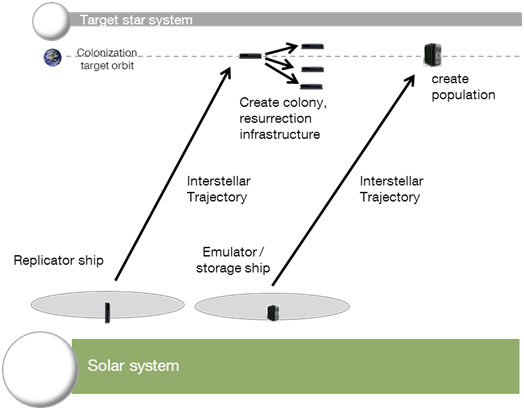
Fig. 2: Split mission with separate replicator and digital payload
Architecture B is based on two spacecraft. The replicator spacecraft is launched first, in order to initiate colony construction way before the emulator spacecraft arrives. This architecture makes sense if colony construction takes decades or centuries. The main advantage is the reduction of risk from a failure to construct the initial colony. The emulator spacecraft could be launched only if the colony is operational. Another advantage is the use of a different propulsion system for the emulator ship, allowing for a shorter trip duration than the replicator ship. A shorter trip duration reduces the risk of failures of on-board systems, which is more critical for the emulator ship as it has in principle a human payload on-board.
Architecture C
1. Send replicator spacecraft
2. Create receiver dishes in target star system
3. Receive data for creating technical systems & humans
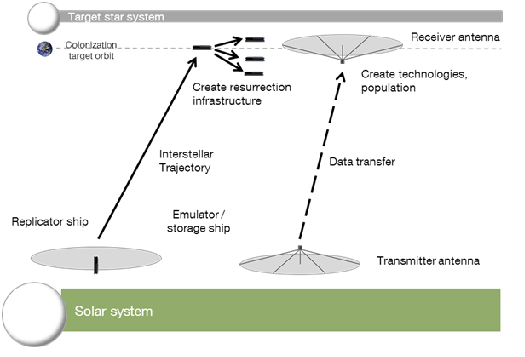
Fig. 3: Replicator mission which builds up a receiver for technologies and humans to be created within the star system
In order to teleport data, a receiver has to be constructed within the target star system first. This is done by the replicator spacecraft’s payload. Apart from the receiver, a molecular assembly facility or universal 3D-printer has to be constructed, which then recreates the original objects. The main advantage of this architecture is the travel duration for the objects transferred, as the data is transmitted is the speed of light.
Architecture D
1. Send replicator spacecraft
2. Build receiver
3. Use wormholes to transmit information to receiver
4. Create technological systems & humans
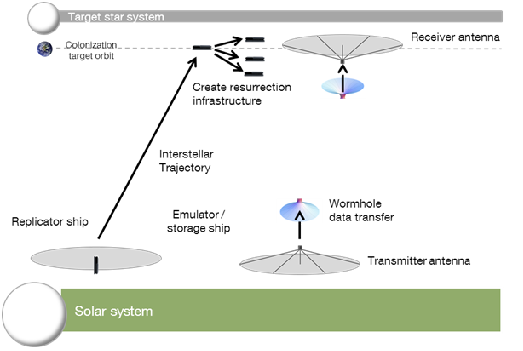
Fig. 4: Using a worm hole for transmitting data for technologies and humans with faster than light speeds
After the construction of a receiver and molecular assembly facility, data is transferred almost instantly through a worm hole or other exotic means.
Conclusions
The concept of brain emulation is often associated with the occurrence of the so-called technological singularity, which is often associated with the emergence of general artificial intelligence and its exponentially increasing capabilities. Whether or not it is reasonable to expect such a singularity to happen is the matter of intense debate among scholars (Sandberg, 2010), (Sandberg & Bostrom, 2011), (Goertzel, 2007). Personal conversations with a range of brain researchers have rather revealed a skeptical outlook on progress in creating brain emulations in the near future. Nevertheless, there is no doubt that progress is being made. Brain emulation and general artificial intelligence should not be discarded on the grounds of current or near-future infeasibility, as we are dealing with timeframes of decades to centuries until interstellar missions are conducted.
As a final remark, Launius & McCurdy point out that a posthuman civilization does not necessarily possess the motivation to conduct an interstellar mission (Launius & McCurdy, 2008, pp.218-219). Thus, one has to keep in mind that changing the human condition so profoundly will certainly have consequences for its behavior as well.
Although the prospects of mind uploading are controversial, its realization within the 21st century should not be deemed infeasible. It is even imperative to think about possible implications of this technology, as its realization would drastically change our civilization as well as it would revolutionize interstellar travel. How would it then feel to travel to the stars? After being scanned, would we suddenly wake up in a new body on an exoplanet? Would we instead pass our time in a virtual world crossing the space between the stars, finally transforming into a biological existence again? Fascinating but also somewhat chilling thoughts…
References
Bekenstein, J. D. (1973). Black holes and entropy. Physical Review D, 7(8), 2333.
Davis, E. W., & Millis, M. G. (2009). Frontiers of propulsion science. American Institute of Aeronautics and Astronautics.
Goertzel, B. (2007). Human-level artificial general intelligence and the possibility of a technological singularity: A reaction to Ray Kurzweil’s The Singularity Is Near, and McDermott’s critique of Kurzweil. Artificial Intelligence, 171(18), 1161-1173.
Hanson, R. (2001). Economic growth given machine intelligence. Journal of Artificial Intelligence Research.
Hanson, R. (2008a). Economics of brain emulations. In Tomorrow’s people – proceedings of the james martin institute’s first world forum: EarthScan.
Hanson, R. (2008b). Economics of the singularity. Spectrum, IEEE, 45(6), 45-50.
Kurzweil, R. (2005). The Singularity Is Near: When Humans Transcend Biology, Penguin Books.
Launius, R. D. (2008). Robots in space: technology, evolution, and interplanetary travel. JHU Press.
Lokhorst, G. J. (2000, May). Why I am not a super-Turing machine. In Hypercomputation Workshop, University College, London (Vol. 24).
Moravec, H. (1988). Mind children. Cambridge, MA: Harvard University Press.
Sandberg, A., & Bostrom, N. (2008). Whole brain emulation: A roadmap. Future of Humanity Institute, Oxford University. Available at: http://www.fhi.ox.ac.uk/brain-emulation-roadmap-report.pdf Accessed July, 3, 2010.
Sandberg, A. (2010). An overview of models of technological singularity. In Roadmaps to AGI and the future of AGI workshop, Lugano, Switzerland, Mar. 8th. http://agiconf. org/2010/wp-content/uploads/2009/06/agi10singmodels2. pdf.
Sandberg, A., & Bostrom, N. (2011). Machine intelligence survey. Technical Report, 2011-1. Future of Humanity Institute, University of Oxford. www.fhi.ox.ac.uk/reports/2011-1. pdf.

The Worldship of 1953
Les Shepherd’s 1952 paper “Interstellar Flight” appears in the Journal of the British Interplanetary Society,” a fitting place given Shepherd’s active involvement in the organization. He would, in fact, serve the BIS as its chairman, first succeeding Arthur C. Clarke in that role in 1954, and returning in 1957 and again in 1965 for later terms of office. “Interstellar Flight” is one of those papers that turns people in new directions after they have read it, and we can see the gradual acceptance of travel between the stars as a possibility that does not violate the laws of physics beginning in its pages.
Much less heralded but more widely seen was an adapted version of “Interstellar Flight” that appeared in Science Fiction Plus in April of 1953. The magazine was a revival of Hugo Gernsback’s career as a science fiction publisher that ran for seven issues before its demise in December of the same year. Gernsback’s name was revered in science fiction circles as the founder of Amazing Stories in 1926, and for his later career with Science Wonder Stories and Air Wonder Stories, magazines he would eventually merge before selling his interest entirely in 1936. In contrast to these earlier titles, Science Fiction Plus was printed on slick paper and featured glossy covers, though many of the writers Gernsback used had worked with him in the Amazing Stories days.

Science Fiction Plus was an interesting venue for Shepherd because it exposed his work to an audience that had already encountered science fiction treatments of interstellar concepts like the generation ships he wrote about in the following paragraph:
At first sight the idea of advancing mankind’s frontiers to points requiring hundreds or even thousands of years to reach, might seem hopeless. It cannot indeed be regarded as a particularly satisfactory picture of interstellar exploration. However, regarded in terms of geological eras, centuries or millennia are small intervals, and provided that human life can be sustained in exploring vehicles for long periods, there is no reason why interstellar expansion should not proceed on this basis.
I can envision the Gernsback audience soaking this up, familiar as many of these readers would have been with stories like Robert Heinlein’s “Universe” and Don Wilcox’s “The Voyage that Lasted 600 Years.” The latter, which appeared in Amazing Stories in October of 1940, tells the tale of one Gregory Grimstone, who spends an interstellar voyage in a state of hibernation, but is wakened once every hundred years as the ‘Keeper of Traditions,’ the one contact the crew still has with the Earth left behind many generations before. Here we have the same theme of lost knowledge and a crew gradually losing the meaning of their journey that we find in Heinlein’s Orphans of the Sky and a variety of later tales.
Image: Pioneering physicist Les Shepherd, whose work on interstellar flight has influenced generations of subsequent researchers.
The magnitude of the journey in terms of space and particularly time is well captured in Shepherd’s essay:
The author is not competent to deal with the biological problems of life on an interstellar vehicle undertaking a voyage lasting for a millennium. Obviously they would assume a magnitude quite as great as the engineering problems involved. In the normal way, some thirty generations would be born and would die upon the ship. It would be as though the vessel had set out for its destination under the command of King Canute and arrived with President Truman in control. The original crew would be legendary figures in the minds of those who finally came to the new world. Between them would lie the drama of perhaps ten thousand souls who had been born and had lived and died in an alien world without knowing a natural home.
Now, as to those italics. They’re clearly Gernsback’s, a suspicion natural to anyone familiar with his editorial style. The JBIS paper containing the identical passage has no italics at this point, and it’s clear that Gernsback wanted to drive home the science fictional ‘sense of wonder’ of Shepherd’s remarks with his typesetting. I’m not sure the audience needed the hint. I still find the idea of multiple generations living and dying aboard an interstellar craft to be mind-boggling even when presented in the lean text of the average scientific paper.
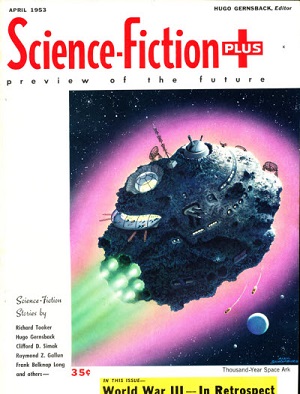
Shepherd would go on to discuss worldship issues ranging from population control — for humans and journeying animals — as well as the huge problem of life-support systems in a self-contained world. He saw the only feasible way to make a journey like this would be in a ship of gigantic proportions, and for him, that meant hollowing out ‘a small planetoid,’ one of perhaps a million tons (excluding the weight of propellants and fuel). He believed artificial gravity should be induced by rotating the ship, and he pondered the question of maintaining an atmosphere over the course of ten centuries. On matters of sociology, he said this:
The passage of perhaps thirty generations would pose major problems of a sociological nature. The control of population would be only one of many. Children could only be born according to some prearranged plan, since overpopulation or underpopulation would be disastrous. The community would be subjected to a degree of discipline not maintained in any existing community. This isolated group would need to preserve its civilization, and hand on precious knowledge and culture from generation to generation and even add to the store of science and art, since stagnation would probably be the first step to degradation.
I don’t want to give the impression that Shepherd’s “Interstellar Flight” is solely about worldships, because the original JBIS paper was wide in its scope, examining nuclear fission, fusion and ion propulsion and going into depth on the possibilities of antimatter. Giovanni Vulpetti has pointed out that antimatter had been little studied in terms of propulsion at the time Shepherd wrote, and it was Shepherd who brought the concept out of the realm of science fiction and into the realm of serious physics with this single paper. We owe much to “Interstellar Flight,” published a year before Eugen Sänger’s famous paper on photon rockets, and I think Shepherd was wise to let Gernsback publish a version of it that could reach a broad popular audience.
As for Gernsback, he was canny to bring a serious study of interstellar travel into the pages of his young magazine, although not as successful when it came to story selection. Science fiction historian Mike Ashley has noted a certain archaism in the fiction here because of Gernsback’s reliance on writers from the previous generation. Even so, one Science Fiction Plus story still stands out. It’s Clifford D. Simak’s “Spacebred Generations,” from the August, 1953 issue. As the title implies, this is a worldship story that flows naturally out of Shepherd’s own speculations. We’ll take a closer look at what Simak has to say in an upcoming post.
Les Shepherd’s original paper on interstellar propulsion is “Interstellar Flight,” JBIS, Vol. 11, 149-167, July 1952, from which the article in Science Fiction Plus was adapted.

Cultural Evolution: The View from Deep Space
I didn’t have the chance to meet Mark Lupisella at the first 100 Year Starship symposium in Orlando, but the publication of Cosmos & Culture: Cultural Evolution in a Cosmic Context in 2013 made me wish I had sought him out. Co-edited with Steven J. Dick (about whom there are so many interesting things to say that I’ll have to carry over into a future post with them), Cosmos & Culture offers essays from scientists, historians and anthropologists about the evolution of culture both on Earth and, most likely, beyond it.
These are, of course, issues we’ve been considering recently in the work of Cameron Smith and Kathleen Toerpe, and in a broader sense they inform many of the SETI and astrobiology discussions we have here. Then Clément Vidal, who is an author and a post-doctoral researcher at the Free University of Brussels, passed along the paper I missed in Orlando, Lupisella’s “Cosmocultural Evolution: Cosmic Motivations for Interstellar Travel.” To be fair to myself, we all missed plenty of papers at the first 100YSS, because there were five simultaneous tracks and it was impossible (at the current state of technology) to be in more than one place at a time.
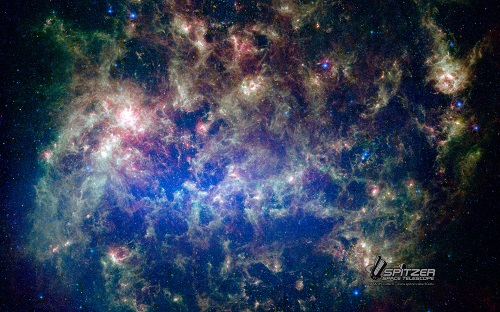
Image: A Spitzer infrared view of the Large Magellanic Cloud, a satellite galaxy to the Milky Way. How we define the human role in a cosmos of such immensity has ramifications throughout our culture. Credit: Spitzer Space Telescope/JPL.
I want to draw on Lupisella’s work this morning because it intersects with an issue I often deal with: How do we state a rationale for expansion into the cosmos? Lupisella discusses a very interesting ‘cosmocultural evolution’ that I’ll get to in a moment, but let’s focus on the motivations for going off-planet that inform any discussion about space. I take it for granted, for instance, that one key driver for a long-term human presence in space is simple survival, the universe being a dangerous place, and our Solar System littered with evidence in the form of space debris and cratered terrain of what can happen when one astronomical body runs into another.
Not everyone agrees with this motivation. I’ve written before about one dinner party where, in the midst of a discussion about everything but the future, one of the guests suddenly asked me why I spent so much time writing about space. It soon became clear that the consensus at the dinner table held that money spent on space was wasted by being diverted from pressing needs on Earth. After I had explained my view that our species needed to insure itself against future catastrophe, my first interrogator said, “Why? I would think that if we found a huge object headed for our planet, we would be doing the universe a favor by letting it hit us and getting it over with.”
So you can’t count on survival as a trump card. And by the way, trying to get past the attitude just cited is probably impossible, because anyone that misanthropic isn’t going to give ground even when reminded that if he did let an incoming asteroid hit the Earth, he would be signing not just his own death warrant but those of his grandchildren and everyone else’s grandchildren as well.
Lupisella sees interstellar flight as “the ultimate insurance policy,” but he brings to the question an added ethical dimension. We should consider our survival as necessary, in this view, because of the possibility that we may ultimately play a role in the broader evolution of the universe. So maybe we want to thrive and prosper not just for ourselves but for the sake of the meaning we can bring to life’s experience in the cosmos.
I find this a heartening view, but let’s add to it some other factors Lupisella pointed to in Orlando. A human presence in space sets up the conditions for countless new experiments in culture and philosophy, which means experiments in everything from social organization to means of governance, all of which would be interesting in and of themselves as well as providing data that could be of use for those remaining on the home world. The cultural experimentation this implies could also be complemented by new contexts for biological evolution — Freeman Dyson has written often about what could happen to our species as we begin to live in radically different environments and essentially begin to fork into various branches of homo sapiens, while the aforementioned Steven J. Dick has explored the emergence of post-biological intelligence.
Cultural diversity flows naturally out of all this, surely healthy for the species, but so does what Lupisella calls a ‘cosmic promotion,’ the reverse of the great demotions we have undergone throughout history as we adjusted our views of the cosmos. We’ve accustomed ourselves to being dethroned from the center of the universe, from being the place around which the Sun revolves, from being at the center of the galaxy, from being in the galaxy as we learned how many of them there are, and so on. Lupisella’s view of cosmocultural evolution suggests that although life, intelligence and culture could arise by chance, they still might have cosmic significance, or as he says, “Modest origins do not imply modest potential.”
Here’s the argument in a nutshell:
If the universe didn’t have value and morality prior, it does now. If it didn’t have meaning and purpose prior, it may now. If it didn’t have intentional creativity prior, it does now. We may be a very small part of the universe that arose by chance, but nevertheless, strictly speaking, the universe now contains morality and a kind of intentional creativity it may not have had prior to the emergence of cultural beings like us. We cultural beings, in some nontrivial sense, make the universe a moral and increasingly creative entity, however limited that contribution may be for now. Increasingly, human culture is expanding its circle of creativity and moral consideration. Perhaps interstellar travel can help expand a circle of moral creativity to the whole of the universe.
Does this remind you of anyone? For me, this is strikingly similar to Michael Michaud’s calls to bring meaning to the cosmos. In one of our dialogues in these pages (see Spaceflight and Legends: A Dialogue with Michael Michaud), the author and diplomat said this:
The moral obligation to assure the survival of intelligence is not imposed on us by gods or prophets, but by our own choices. Call that anthropocentrism if you will. I prefer to think of us as independent moral agents, perhaps the only ones in the galaxy. Until and unless we discover another technological civilization, we have a unique responsibility to impose intention on chance.
I love that phrase ‘to impose intention on chance’ and have used it in several talks. You may have run into Carl Sagan using language a bit like this. When pressed on what happens to humanity in a universe that can seem without meaning, Sagan would reply “Do something meaningful.” I take this to mean, whatever your views, whatever your angle on life, shape events toward a meaningful outcome. Don’t, in other words, let that asteroid hit the Earth. And no matter how bewildered you may be about your place in the cosmos, go forward and do your best.
I draw strength from Lao Tzu: “You accomplish the great task by a series of small acts.” The things we do every day to give meaning to our lives matter. Make them count.
Lupisella notes that in 2007, a panel of experts meeting at the Future of Space Exploration Symposium at Boston University recommended that a 50-year global vision be developed to guide future human space efforts. I am all for such long-term thinking and believe it dovetails nicely with our growing understanding of the meaning we can bring into being as we work. How energizing it is to see the cultural issues of future spaceflight in active discussion. Clément Vidal, by the way, has a book of his own coming out. I look forward to seeing The Beginning and the End: The Meaning of Life in a Cosmological Perspective, just published by Springer.

Putting the ‘Giggle Factor’ to Rest
Can we overcome our preconceptions about extraterrestrial life? Kathleen Toerpe thinks the answer is yes, for we’re moving from the era of ill-informed jokes about ‘little green men’ to a widening appreciation of our place in the cosmos. Dr. Toerpe is the Deputy CEO for Programs and Special Projects at the Astrosociology Research Institute and editor of The Journal of Astrosociology. She also serves as a NASA/JPL Solar System Ambassador, one whose educational efforts on behalf of space exploration have revealed that the younger generation is familiar with and inspired by the subject, a fact that gives this essay its welcome patina of optimism. The recent hearings on SETI in the U.S. House of Representatives show that, for some at least, old attitudes die hard, but ongoing research into astrobiology and SETI is likely to make the ‘giggle factor’ seem positively prehistoric within our lifetimes.
by Kathleen D. Toerpe, PhD

Flip through any newsfeed these days, and it seems that humanity is experiencing an extraterrestrial renaissance. No, I’m not talking about the reboot of the Star Wars franchise, though that reawakening has been long overdue. Rather, I’m referring to the deservedly serious discourse in both the popular and scientific press over the search for extraterrestrial life (henceforth, shortened to “ET” – with both apologies and credit to Mr. Spielberg).
Two prominent examples here make my point.
On May 22, 2014, NASA released a free downloadable eBook edited by SETI social scientist, Douglas A. Vakoch, titled Archaeology, Anthropology, and Interstellar Communication. This fascinating book (which consumed much of my attention the recent Memorial Day weekend) examines the multilayered and interdisciplinary approaches that social scientists employ to anticipate how we might communicate with intelligent beings from another planet. Hearkening to analogs in Mayan hieroglyphs, music theory, Neanderthal research, and decoding extinct Earth languages (among several other fascinating analogs), this compilation of conference presentations teases out the seemingly intractable challenges of decoding and interpreting a message sent from ET and the possibilities of composing our own message in response.
A day earlier, on May 21, 2014, Seth Shostak and Dan Werthimer, two of SETI’s most eminent radio astronomers, testified before the House Committee on Science, Space, and Technology about “Astrobiology and the Search for Life in the Universe.” The hearings focused on the progress made by radio and optical astronomy in detecting extraterrestrial life in the universe, and followed a similar hearing in December of 2013 that focused on the search for alien microbial life. Both Shostak’s and Werthimer’s prepared remarks thoroughly updated the House Committee on the rationales for the search, the search modalities, and the successes, challenges, and future direction of SETI investigations: atmospheric investigations into exoplanetary biochemical signatures, optical SETI recording intermittent pulses of light, panchromatic searches canvassing even broader swaths of the electromagnetic spectrum, even eavesdropping on our exoplanet neighbors for inadvertent signal leaks.
Serious science all around. But a final question, posed by the hearing’s Charter, asked the scientists to speak to the “public interest in the topic.” While Werthimer’s written testimony offered examples of SETI-inspired poetry and citizen science projects (the latter not surprising since the solidly popular and successful SETI@home project is headed out of Werthimer’s UC-Berkeley office), Shostak revealed the five-hundred-pound gorilla lurking in the background. This particular gorilla is commonly known as the “Giggle Factor.”
It is the immediate response many people have when the subject of ET and aliens arise. That under-the-breath chortle, that second look as if to say, “You’re really serious about this?” Psychologist and astrosociologist Albert Harrison analyzed it in his 2005 paper, “Overcoming the Image of Little Green Men: Astrosociology and SETI” and warned especially early-career SETI researchers to “be prepared . . . to risk ridicule . . . and public censure.” It was this same attitude that unfortunately earned SETI research that infamous 1979 “Golden Fleece Award” from former Wisconsin Senator William Proxmire. (Proxmire later recanted, but the damage to SETI’s reputation was done.) I suspect that every serious SETI researcher from the earliest pioneers to today’s practitioners has faced their peers’ and even their audience’s giggles. But I’m going to echo Shostak’s optimistic prediction to the House committee on the imminent discovery of ET life, and likewise guess that the Giggle Factor “is going to change within everyone’s lifetime in this room.”
What gives me the confidence to predict the demise of the Giggle Factor?
One simple word. Children.
One of the many “hats” I wear is as a volunteer NASA/JPL Solar System Ambassador. That is an auspicious-sounding way of saying that I present programs on space research and exploration to anyone in my community who wants to listen to me. Schools, scout troops and packs, senior centers, college classes, library programs, astronomy groups, radio interviews, church luncheons are all some of the places where I and my fellow Ambassadors carry the message of outer space to the public. And I’ve heard my share of giggles when I discuss Kepler exoplanetary discoveries, the Mars Curiosity Rover, and astrobiology research. But here’s the thing: the little kids aren’t laughing. Not a giggle. They wiggle and squirm, they want to play with the beach ball-like planets I bring with me, and they always want to know how much longer until snack time—but they don’t giggle. Not a chortle. Not a guffaw. Instead, there are a lot of wide eyes and dropping jaws when I describe the enormity of space and the possibilities of extraterrestrial life.
In a program I created called “Hello Out There!” we cover the science on Kepler and Curiosity and the Voyager probes, then the kids do their favorite part: composing their own messages on a cardboard “Golden Record” that they take home to share with their families. If Doug Vakoch would like to know what the scientists of tomorrow are most interested in telling ET about, it is . . . drum roll . . . their pets! In my informal review of the times I’ve presented this program (and I’m doing it with another 200 or so children this summer!) children want to tell ET about their pets, their siblings, their parents, and their favorite foods. Perhaps not quite the esoteric mathematical or chemical equations many active-SETI or messaging groups discuss sending, but it hearkens back to the more intimate and simply human messaging of the real-life Voyager recordings.
In his analysis on applying the techniques of archaeology to SETI, archaeologist and NASA e-book contributor Paul Watson concluded that we might be trapping ourselves in an “intellectual context” – our inability to overcome our preconceptions about alien life. Perhaps this is where an analysis of the Giggle Factor best finds its final resting place—as a cultural preconception. Even some of the House committee members couldn’t resist the urge to cast SETI in what Shostak earlier in the hearing had referred to as a “punchline.” House members’ questions about Ancient Aliens, Project Blue Book and UFO visitations, and whether or not ET likes the Beatles songs we’ve been sending out in space all seemed sadly discordant with the official formalities of a Congressional committee hearing. The Giggle Factor dies hard for us adults.
Committee Chairman Lamar Smith’s (Texas) comment that “finding other sentient life in the universe would be the most significant discovery in human history” is no melodramatic hyperbole. The sheer discovery of even microbial life will be far-reaching, especially if it provides confirmatory evidence of an independent DNA structure. It is even more difficult to exaggerate the human impact of the discovery of intelligent extraterrestrial life, though as astrosociologists, I and my colleagues try hard to imagine and anticipate it. It would, in Shostak’s words, “calibrate our place in the intellectual universe.” Even finding nothing will be worth the search, since it would reaffirm, according to Werthimer, that “life on this planet . . . is very precious.” Indeed it is, whether or not we ever hear from ET!

Image: Meeting of the House Committee on Science, Space, and Technology about “Astrobiology and the Search for Life in the Universe.” Credit: Library of Congress.
There is serious work to be done to prepare for the likely detection of extraterrestrial life—by both scientists and social scientists alike. Computing power needs to be enhanced to deal with the massive volume of data being acquired; more sensitive land and sky-based instruments are needed to listen and peek in on the cosmos; media protocols to govern public disclosure of a putative signal detection need to be reviewed, revised and updated; public policy regarding ownership of and access to extraterrestrial microbial samples needs to be negotiated; and — my personal research field — more analysis is needed into the readiness of Earth societies and institutions to assimilate the likely knowledge that we are not alone. And this just scratches the surface of our SETI to-do list!
Once exiled to the fringes of legitimate scientific inquiry by the Giggle Factor, the search for extraterrestrial life has gained new momentum, focus, and funding as the search broadens to encompass the search for microbial, in addition to intelligent, life. In the end, it may be the children who lead the way into a new future for SETI. In his opening statement, Committee Chair Smith reminded the high school students in attendance at the hearing that day that one of the hearing’s purposes is “to inspire students today to be the scientists of tomorrow.” And the noticeable lack of giggling in the room was magic to my ears.
———–
Kathleen Toerpe can be reached at ktoerpe@astrosociology.org and can be found at @ktoerpe on Twitter.
The video of the House Committee on Science, Space, and Technology’s hearing on “Astrobiology and the Search for Life in the Universe,” and the participants’ written statements are available at http://science.house.gov/hearing/full-committee-hearing-astrobiology-and-search-life-universe
Albert Harrison’s 2005 paper, “Overcoming the Image of Little Green Men: Astrosociology and SETI” is available at http://astrosociology.com/Library/PDF/submissions/Overcoming%20LGM_Harrison.pdf
Information on the NASA/JPL Solar System Ambassador program is available at http://www2.jpl.nasa.gov/ambassador/


